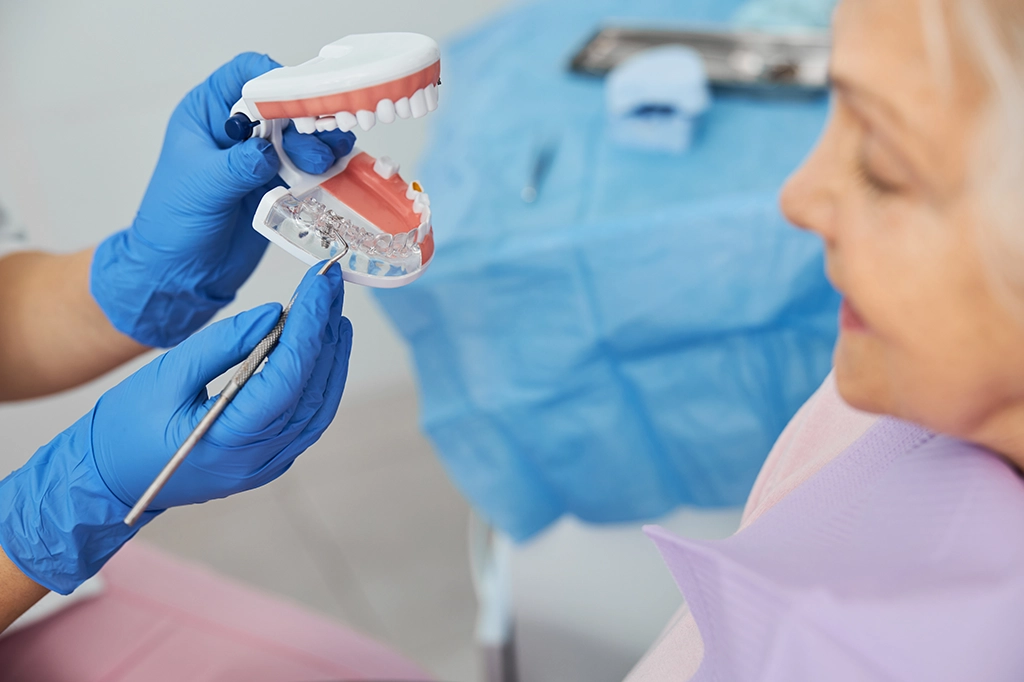While it’s true that Single Tooth Implants are becoming more common and there have been many advancements in dental care, there are still millions of Americans that suffer from tooth loss which affects their appearance, confidence, and proper functioning . Some of the most common causes of tooth loss are:
For a long time, the only options for patients with missing teeth were removable partial dentures and dental bridges. However, at A Dental Care / Lifetime Dental and Implant center, one of our options for single tooth replacement is a single implant.
A dental implant is a titanium screw that is surgically implanted into your jawbone to replace a missing tooth. Once the dental implants are in place, the dentist can attach a prosthetic tooth to it. The prosthetic tooth looks, feels, and acts like a natural tooth. If you are missing one tooth, a single implant and crown can replace it. A dental implant replaces the root and the natural tooth.
During the initial surgery, an implant will be placed into the jawbone. Then, you will be given 2 3 to 6 months for the bone to osseointegrate, or fuse, with the implant. During this time, we will place a temporary tooth over the implant site.
Once the implant has fused with the jawbone, we will remove the temporary tooth and attach an extension to the implant, known as an abutment. This will complete the foundation on which your new prosthetic tooth will be placed. Typically, we will allow your gums to heal for a couple of weeks after this.


We do have an implant system that does not require this step because the implant already has the abutment attached. We will determine which option is best for you during your consultation visit.
The final step in this process is placement of your permanent crown. The lab will create a prosthetic tooth that matches your natural teeth so that no one will know the difference and they look, feel, and act like a natural tooth, so you may even forget that you were ever missing a tooth.
The entire process of getting a dental implant can take several months. If your jawbone is not sufficient enough to place a dental implant, you will need to undergo a bone grafting procedure first.
Bone grafting is a procedure where we will extract bone from another source or use a synthetic material to make your jaw more robust. Healing from a bone grafting procedure may take up a full year, which will delay implant placement.
As mentioned, if your jawbone is not sufficient enough to support a dental implant, we do have several options to increase the bone:
For some of our patients at A Dental Care/ Lifetime Dental and Implant Center, a dental bridge or dentures is not an option due to a variety of reasons:

Also, a traditional dental bridge must be fixed to the natural teeth on either side of the gap where the missing tooth was. One of the benefits of a dental implant is that we don’t need to involve any of your natural teeth to place your prosthetic tooth.
Candidates for single tooth implants must:
Before we schedule your single tooth implant procedure at A Dental Care/ Lifetime Dental and Implant Center , the dentist will perform a comprehensive exam and review your medical history. There are several medical conditions that will prevent you from receiving a dental implant, including:

If you are missing a tooth due to decay, trauma, gum disease, genetics, or other reason, a single tooth implant can help. A dental implant replaces the missing tooth and its root, which will prevent bone loss due to missing teeth. It is designed to look, feel, and act like a natural tooth.
Single Tooth Implant Healing & Aftercare
There is no standard recovery time following dental implant treatment. At A Dental Care/ Lifetime Dental and Implant Center, we know that everyone is different, and recovery is on a case-by-case basis. There are several factors that may affect treatment:
Most dental implant procedures are done under a local anesthesia, but for patients who have high dental anxiety, we do offer IV or oral sedation
In a standard dental implant procedure with little to no bone grafting, most patients have little to no swelling or discomfort. You should be able to continue life as usual from the next day.
Careful brushing/cleaning of the surgical site and a soft diet for a few days may be all that you need following treatment. Most patients only have minor swelling or discomfort, and, in some cases, you may have bruising that lingers for a few days.

That being said, the dentist will prescribe medication and give you clear aftercare instructions to manage your symptoms. After about 7 to 10 days, you should be able to return to your typical diet and routine. In rare cases, patients must stick to a soft diet for up to 6 weeks after surgery.
If bone grafting is required, you can expect swelling to be more substantial. The dentist will provide you with aftercare instructions and medications to keep you comfortable.

As long as you practice proper oral hygiene, dental implants can last a lifetime. However, the crown may need to be replaced after about 10 to 15 years- but that may be extended with excellent hygiene practices.
Another factor in the life expectancy of a dental implant is the location of the implant. For example, implants located in the rear of the mouth are used for chewing, so they are more likely to wear out before implants located in the front.
Proper instructions are not followed
Continued smoking

Some of the uncommon risks associated with dental implants involve the placement of the implant:
Dental implants offer several advantages over other tooth replacement procedures. In addition to looking, working, and feeling like a natural tooth, an implant can replace a missing tooth without affecting the surrounding perfectly healthy teeth.
Another common option to replace missing teeth at A Dental Care/Lifetime Dental and Implant Center is a dental bridge- but this solution requires that neighboring teeth are filed down to support the bridge.
A dental implant replaces the tooth root as well, which preserves your jawbone. However, with a dental bridge, the bone below the missing tooth will ultimately deteriorate. Plus, a bridge requires neighboring teeth to be strong and healthy or additional teeth may be compromised.
Dental implants are more aesthetically pleasing and easier to clean than a bridge. If you have a bridge, your gums may begin to recede, which allows the metal base of the bridge or the root part of the tooth to be seen, creating an unattractive smile & site for food lodgement
Finally, the cement holding the bridge in place may wash out, allowing bacteria in to enter under the existing bridge which can cause the anchoring teeth to decay.
The advantage that a dental bridge has over a dental implant is the fact that it is the cheaper might be a less expensive option.
Typically, dental implants are more expensive than other options, costing between $3,000 to $4,000. This does not include additional procedures such as x-rays, CT scans, exams, Sedation bone grafting/sinus lifting, and other additional procedures that Might be necessary for the best outcome of the treatment.
Unfortunately, many dental insurance companies view implants as an elective procedure, even though this is the standard for missing tooth replacement. Therefore, most of the time, they will not cover implants, but may cover a portion of the crown. We will work with your insurance company to determine coverage.
If you are missing teeth and think you may qualify for a single dental implant, schedule your consultation with A Dental Care/Lifetime Dental and Implant Center today. We have four offices in Houston, as well as one in Spring and one in Katy. We will be happy to help you decide the best course of treatment for replacing your missing teeth.
About Us
At A Dental Care, we understand the importance of having access to emergency dentistry services in Houston, TX. We provide comprehensive dental care in Houston, TX for individuals who need urgent attention and are committed to providing excellent customer service. Rated as one of the Best Dentists in Houston, TX.
2022 © A Dental Care. All Rights Reserved.
Dental Marketing by WEB MARKETING FOR DENTISTS